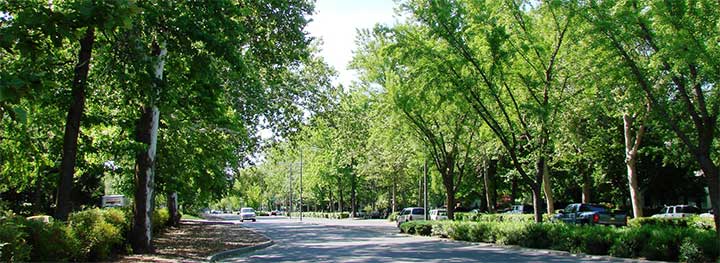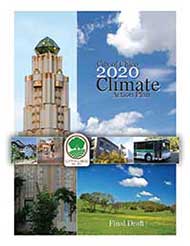
In an effort to stabilize GHG emissions and reduce impacts associated with climate change, international agreements, as well as federal and state actions were implemented as early as 1988. The international, federal, state, regional, and local government agencies discussed below work jointly, as well as individually, to address GHG emissions through legislation, regulations, planning, policy-making, education, and a variety of programs.
International and Federal Climate Actions
International Climate Action - Kyoto Protocol
In 1994, the United States signed onto the United Nations Framework Convention on Climate Change (UNFCCC). The Kyoto Protocol, adopted in 1997 by 37 industrialized nations, is a treaty made under the UNFCCC, which sets binding targets for GHG reductions over a five-year period from 2008 to 2012 to meet a goal to reduce GHG emissions below 1990 levels. It was estimated that if the commitments outlined in the Kyoto Protocol are met, global GHG emissions would have been reduced by an estimated 7% from 1990 levels by 2012. However due to international failure to meet the Kyoto commitments, the rate of global GHG emissions increased during the target period. It should be noted that although the United States is a signatory to the Kyoto Protocol, Congress has not ratified the Protocol and the U.S. is not bound by the Protocol’s commitments.
Federal Climate Action
In lieu of the Kyoto Protocol’s mandatory framework, the United States has opted for a voluntary, incentive-based approach toward reducing its 25% of the world’s global warming pollutants. The Climate Change Technology Program is a multi-agency research and development coordination effort which is charged with carrying out the President’s National Climate Change Technology Initiative. The United States Environmental Protection Agency (USEPA) is responsible for implementing federal policy to address global climate change. The Federal government administers a wide array of public-private partnerships to reduce GHG emissions. These voluntary programs focus on energy efficiency, renewable energy, methane and other non-CO2 gases, agricultural practices, and implementation of technologies to achieve GHG reductions.
In 2010, the USEPA issued a “Final Rule” using the Clean Air Act permitting process to address GHG emissions from stationary sources, such as fossil fuel and industrial gas suppliers, direct GHG emitters, and manufacturers of heavy-duty and off-road vehicles and engines. The Rule does not regulate the generation of GHG emissions, but instead requires mandatory monitoring and reporting of GHG emissions from sources that exceed a GHG emissions threshold of 75.000 MtCO2e per year.
California Climate Action
With the largest population in the United States and an economy that is larger than that of most countries, California produces about 1.4% of worldwide GHG emissions and 6.2% of U.S. GHG emissions (State of California, 2011). During the last decade, California emerged as the leading state taking actions to reduce GHG emissions. On the private side, alternative energy industries have flourished in California. On the public policy side, California has enacted unprecedented climate legislation. In addition to statewide legislation, a local grassroots action to address climate change has also taken hold in California. Of the 677 colleges and universities in the country that have signed onto the American Colleges and Universities Presidents’ Climate Commitment (ACUPCC), 66 (or nearly 10%) are in California (ACUPCC, 2011).
Prior to action at the federal level, and ahead of any other state in the nation, California has enacted the following series of standards:
Executive Order S-3-05
In June 2005, Governor Arnold Schwarzenegger issued a landmark executive order establishing GHG reduction targets for the entire state:
- By 2010, reduce emissions to 2000 levels;
- By 2020, reduce emissions to 1990 levels;
- By 2050, reduce emissions to 80% below 1990 levels to reach a stable level.
Assembly Bill 32
To support these GHG-reduction targets, the California Legislature adopted the California Global Warming Solutions Act of 2006, also known as Assembly Bill 32. The law requires the California Air Resources Board (CARB) to develop regulatory and market mechanisms to reduce statewide GHG emissions to 1990 levels by 2020. Three new regulations are proposed as discrete preliminary GHG reduction measures, including:
- A low carbon fuel standard;
- Reduction of HFC-34a emissions from non-professional servicing of motor vehicle air conditioning systems;
- Improved landfill methane capture (CARB 2007).
CARB has estimated that statewide GHG emissions for the year 1990 were 427 million MtCO2e and for the period of 2002-2004 were 469 million MtCO2e. CARB also determined that in the absence of action to reduce or mitigate GHG emissions the state would emit 596 million MtCO2e by 2020. CARB’s 2020 projection is known as a business as usual (BAU) projection. To achieve the AB 32 GHG emission reduction goal to reduce emissions to 1990 levels by 2020, the state of California would have to reduce 2020 BAU emissions by approximately 30%.
In December 2008, CARB adopted the Climate Change Scoping Plan, which outlines the State’s strategy to achieve the AB 32 GHG reduction goal for 2020. This Scoping Plan proposes a cap-and-trade program and a comprehensive set of actions designed to reduce overall GHG emissions in California, improve the environment, reduce dependence on oil, diversify energy sources, save energy, create new jobs, and enhance public health. The Scoping Plan also identifies reducing emissions to 15% below “current” levels (which is defined as emissions generated during the years between2005 and 2008) as the equivalent of reaching the 1990 GHG emissions level.
The State’s measures listed in the Scoping Plan will also have a local impact, helping Chico achieve its GHG emissions reduction goal. Where possible, those projected local emissions reductions from State actions have been accounted for in this Climate Action Plan.
Senate Bill 97
Enacted in 2007, this legislation amended the California Environmental Quality Act (CEQA) to establish that GHG emissions and their effects are appropriate subjects for CEQA analysis. SB 97 directed the California Office of Planning and Research (OPR) to draft State CEQA Guidelines “for the mitigation of GHG emissions or the effects of GHG emissions” and directed the Resources Agency to certify and adopt the State CEQA Guidelines.
Senate Bill 375
This bill, signed in 2008, links regional transportation plans with state GHG-reduction goals. Under SB 375, state agencies and local metropolitan planning organizations, such as the Butte County Association of Governments (BCAG), must develop Sustainable Community Strategies to reduce GHG emissions. The focus of the legislation is to reduce single passenger vehicle trips through smart growth and sustainable land use decisions.
Executive Order S-13-08
In November 2008, the governor instructed the California Natural Resources Agency (CNRA) to spearhead the creation of a climate adaptation strategy. The resulting 2009 Climate Adaptation Strategy, a cooperative effort among multiple state agencies, articulates how the state could respond to consequences of climate change, such as rising temperatures and sea levels, new rainfall patterns, and extreme weather events. In November 2010, the state released the First Year Progress Report to detail how the Adaptation Strategy was being implemented.
2010 California Green Building Standards Code CALGreen
California’s Energy Efficiency Standards for Residential and Nonresidential Buildings (California Code of Regulations Title 24, Part 6) were first established in 1978 in response to a legislative mandate to reduce California’s energy consumption. The standards are updated periodically to allow for consideration and incorporation of new energy efficiency technologies and methods. Energy efficient buildings require less electricity, which is often produced from fossil fuels resulting in GHG emissions, and the increased energy efficiency results in decreased GHG emissions.
In 2010, Title 24 was updated to include the “California Green Building Standards Code”, referred to as CALGreen. CALGreen requires that new buildings reduce water consumption, increase system efficiencies, divert construction waste from landfills, and install low pollutant- emitting finish materials. CALGreen has approximately 52 nonresidential mandatory measures and an additional 130 optional provisions. This landmark code will significantly contribute to reducing GHG emissions, energy consumption, and water conservation throughout the state.


